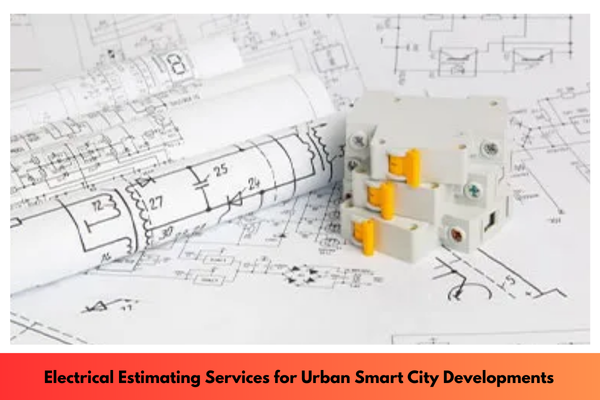Urban smart city developments are reshaping how we live, work, and interact with the built environment. As the world becomes more interconnected, cities are adopting innovative technologies that make them smarter, more efficient, and more sustainable. One of the core components of these urban developments is the electrical infrastructure, which powers everything from street lighting and transportation systems to residential complexes and commercial buildings. However, with the complexity and scale of smart city projects, accurate and efficient electrical estimating services are crucial for their success. This article explores the role of electrical estimating services in smart city developments, focusing on the need for precision, the processes involved, and the benefits of leveraging technology to enhance estimating accuracy.
The Need for Precision in Electrical Estimating for Smart Cities
Smart cities are more than just a collection of technological upgrades in urban spaces. They represent a comprehensive approach to urban planning, integrating digital systems with physical infrastructure to improve the quality of life for residents. These systems include IoT-enabled devices, data analytics, intelligent transportation networks, renewable energy solutions, and more. The electrical infrastructure that supports these systems must be precisely designed and efficiently installed to meet the demands of a modern urban environment.
Electrical estimating services play a vital role in ensuring that the electrical systems are designed, budgeted, and installed within the project’s scope, timeline, and financial parameters. Precision estimator help to predict the cost of materials, labor, and time required for electrical installations and maintenance. In smart city developments, where projects are often large, multifaceted, and high-tech, the margin for error in electrical estimating is slim. A small miscalculation can lead to significant cost overruns, project delays, and operational inefficiencies.
Key Aspects of Electrical Estimating in Smart City Projects
- Project Scope and Complexity
Smart city projects typically involve a wide variety of electrical systems, including lighting, power distribution, data cabling, and renewable energy installations (solar panels, wind turbines, etc.). In some cases, these systems need to be integrated into existing infrastructure or designed from the ground up. Estimating services must take into account the complexity of the project’s scope, which might include smart grids, electric vehicle (EV) charging stations, advanced street lighting, energy storage solutions, and building automation systems. Each of these elements requires specialized knowledge and careful assessment of the required resources. - Material Costs
The selection of materials in smart city electrical installations is critical to ensure sustainability, efficiency, and durability. Materials such as energy-efficient lighting fixtures, smart meters, and solar panel systems come with varying costs based on their specifications. A precise electrical estimator needs to consider the quality, longevity, and compatibility of materials, especially as cities transition toward energy-efficient and green solutions. The use of renewable energy components may also introduce new considerations regarding installation costs and long-term savings. - Labor and Skillset
Electrical contractors working on smart city projects must possess specialized skills to install and maintain advanced systems. Estimating services must take into account the specific qualifications required for the labor force, including the need for electricians trained in smart grid technologies, automation systems, and renewable energy technologies. Labor costs can vary significantly based on the skill level required, as well as regional differences in wage rates. Estimator must therefore accurately assess labor requirements to avoid underestimation. - Time Management
Time is a critical factor in any large-scale urban development, and smart city projects are no exception. Delays in the installation of electrical systems can cause cascading delays in other areas of the project, impacting overall timelines and costs. Electrical estimator need to consider factors such as project sequencing, the coordination between different contractors, and the lead time for procurement of materials. By carefully analyzing these variables, estimator can provide more accurate schedules that help project managers anticipate potential bottlenecks and avoid unnecessary delays. - Technological Integration
One of the defining characteristics of smart cities is the integration of cutting-edge technologies. Electrical systems in smart cities often include high-tech components like automated streetlights, grid-responsive infrastructure, and data-driven traffic management systems. Estimating the costs of integrating these technologies into a city’s electrical network requires an in-depth understanding of both the technical and economic factors involved. Estimator must stay abreast of the latest advancements in electrical engineering to accurately predict the costs associated with these innovations.
The Estimating Process in Smart City Electrical Projects
The process of electrical estimating for urban smart city developments is both detailed and systematic. Precision estimator follow a series of steps to produce an accurate estimate that aligns with the project’s goals and financial constraints.
- Initial Design Review
The first step in the estimating process involves reviewing the project’s design. Estimator study the plans and specifications provided by architects, engineers, and urban planners. This phase may involve meetings with key stakeholders to clarify project goals, constraints, and requirements. Understanding the scope of work and the specific electrical needs of the development is essential for making accurate predictions. - Quantity Takeoff
Once the design is understood, the estimator begins the quantity takeoff process. This involves measuring and counting all the components required for the electrical installation, such as wires, conduits, panels, light fixtures, and transformers. Modern tools, such as Building Information Modeling (BIM) and digital takeoff software, help estimator quickly and accurately capture the quantities and specifications of each material needed. - Cost Estimation
The next phase involves calculating the costs of the materials and labor required for the project. This includes estimating material prices based on current market rates, factoring in transportation costs, and calculating labor costs based on time estimates and wage rates. For smart city projects, the inclusion of high-tech components such as sensors, automated systems, and renewable energy infrastructure requires additional analysis to ensure accurate cost forecasting. - Risk Assessment and Contingency Planning
Smart city projects, due to their scale and complexity, are often subject to unforeseen challenges. Estimator must consider potential risks such as supply chain disruptions, technological changes, or regulatory issues that might affect the project. Including a contingency budget in the estimate helps ensure that the project can absorb unforeseen expenses without jeopardizing the project’s financial viability. - Final Estimate and Report
After completing the cost calculations, the estimator compiles the final estimate, which includes a detailed breakdown of materials, labor, and other associated costs. The final report is presented to project managers, contractors, and stakeholders for approval and decision-making.
Benefits of Precision Electrical Estimating Services for Smart City Developments
- Cost Control
One of the most significant advantages of precision electrical estimating services is the ability to control costs. Accurate cost estimation ensures that the electrical component of a smart city project stays within budget, preventing overruns and financial strain. This is particularly important when working with new and evolving technologies, where unexpected costs can arise. - Improved Project Planning
Precise estimates allow for better project planning and scheduling. With a detailed understanding of the materials and labor required, project managers can allocate resources more effectively, coordinate different aspects of the project, and anticipate any potential delays. - Increased Stakeholder Confidence
A reliable and accurate estimate builds trust among stakeholders, including city planners, contractors, investors, and residents. It demonstrates that the electrical system is being designed and executed with foresight, which is crucial for the long-term success of smart city projects. - Sustainability and Efficiency
As cities move toward more sustainable and energy-efficient solutions, precision estimator can help identify cost-effective and environmentally friendly materials and technologies. This can lead to significant long-term savings and a reduced environmental impact.
Conclusion
In the rapidly evolving landscape of urban smart city development, electrical estimating services are more critical than ever. With the integration of advanced technologies and the growing complexity of electrical systems, precision estimator help ensure that electrical infrastructure is designed, installed, and maintained efficiently and cost-effectively. By leveraging accurate estimating techniques and advanced tools, estimator play an essential role in delivering smart city projects that are both economically viable and technologically innovative. As cities continue to evolve into interconnected hubs of innovation and sustainability, the role of electrical estimating will only become more significant in achieving the goals of modern urban living.


1 Comment
Pingback: best guest posting links websites for construction - Wellbeingprotips